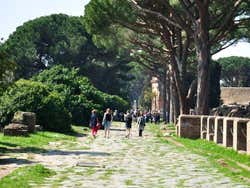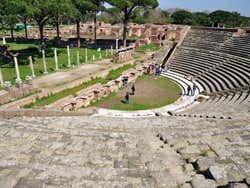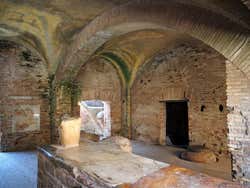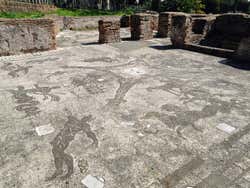
Ostia Antica
Once the harbour city of ancient Rome, Ostia Antica is now a vast archeological site, located near the city of Rome. The town was abandoned and buried for over ten centuries until it was rediscovered.
Nowadays, Ostia Antica is a large archaeological site. Located just 19 miles (30 km) west of Rome and on the River Tiber. During ancient Rome, it was one of the most thriving cities in the region thanks to its status as Rome’s harbour city.
After the collapse of the Empire, the city fell into decadence, was eventually abandoned and remained untouched and magnificently preserved for centuries.
History
Ostia Antica became Rome’s main seaport during the Roman Republic (509 BC – 27 BC) and the city was largely improved by Julius Caesar and Tiberius, during part of the Roman Empire. Nevertheless, the Romans slowly began to depend on other ports, meaning that the commercial activity in Ostia slowed down until it fell into decay during the fourth century AD.
During the same period, the inhabitants of Ostia were hit by malaria and many fled to save their lives. This is how a city which had once a population of 100,000, was abandoned and turned into a forgotten port during several centuries.
The city is relatively well preserved, but not as well as Pompeii or Herculaneum, where the cities were completely buried under volcanic ash and mud.
What to see
The archaeological site still houses the remains of most of the city’s buildings before it was abandoned.
Ostia’s main arterial street, called Decumanus Maximus in Roman cities, cuts through the whole city, while the arcades on both sides of the street show the houses and shops which once thrived here. There are also taverns, inns, shops, public baths and a large reconstructed theatre, which is still used during the summer.
The harbour city had a very cosmopolitan population, visible thanks to a Jewish synagogue, a Christian Basilica and the 18 temples dedicated to the Persian god Mithra.
Less interesting than Pompeii
If you aren’t going to visit Pompeii or Herculaneum, then Ostia Antica is an archaeological site well worth visiting in which it is possible to imagine how the city’s inhabitants lived centuries ago. However, compared to Pompeii or Herculaneum, it is less impressive and less well preserved.
If you visit the site during the summer, we recommend taking water and a hat to protect you from the sun, since there is little shade in the site.
Directions from Rome
Unless you have a car or wish to book a guided tour, Ostia Antica is very close to Rome and is easy to get to by public transport.
To get there using public transportation take the metro (line B) and get off at Piramide. Here, take the Roma Lido commuter train to Ostia Antica. Once at the station, all you have to do is follow the crowd. It is a 10-minute walk away.
The train to Ostia costs € 1.50 (US$ 1.74) (like any other one-way journey). Since you are going to use quite a lot of public transport, you might want to buy a day pass.




Schedule
Tuesday – Sunday: 8:30 am – 4:30 pm, 5:15 pm, 6:30 pm or 7 pm (depending on the season)
Closed: Monday, 25th December, 1st January
Price
Adults: € 18 (US$ 20.98)
EU Citizens aged 18 - 25: € 2 (US$ 2.33)
Children under 1 metre and people with disabilities: free
25th April, 2nd June and 4th November: free
Ostia Antica Half-Day Trip from Rome € 49 (US$ 57.12)
Nearby places
Rome Fiumicino Airport (5.6 km) Basilica of St. Paul Outside the Walls (19.2 km) Trastevere (20.4 km) Janiculum Hill (20.7 km) Basilica di Santa Maria in Trastevere (21 km)

